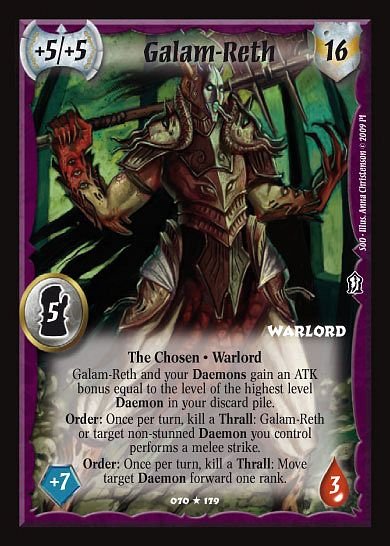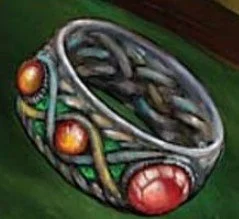Warlord Deckbuilding: Getting Started
/How do you build a competitive Warlord deck? There are probably many many different ways to answer this question. In this article I will provide insights into one deck building method I believe to be quite helpful. Hope you enjoy!
Step 1: Decide on a Warlord
There are any number of ways to make this decision: if you have a particular faction, class and/or subclass you want to play, that will narrow the field quickly. Maybe you like a particular Warlord’s ability, or art, or flavor. If there’s a particular combo you want to use pick a Warlord who will help you set up that combination as quickly as possible, like King Xod or Kaimi Fateseeker for items, Allisara for characters, or Caitlyn the Free for actions.
Step 2: Decide what do you want your Warlord to do
Each faction and class has a number of different ways to play out the game. Ideally, you want all of the cards in your deck working synergistically towards that one goal. Some Warlords will buff their armies (particularly Clerics, Necromancers, Summoners, Bards and certain Fighters, like Sir Robert the Vigilant). Some Warlords will try to get in their opponents’ faces as quickly as possible (Rogue Assassins and Scouts, Front-line Fighters, and Spell Blitz Wizards). Some Warlords will build up to an unstoppable combo or power level (Combo Wizards or Rogues, Uber Fighters or Rogues). Other Warlords will try to choke their opponents out of the game (Seers, Druids, and Illusionists). Any Warlord can play any of these styles, but each Warlord has their own strengths and weaknesses, which leads into…
Step 2b: Capitalize on what makes your Warlord unique
Every faction has at least 2 Warlords per class, which means if you’ve got a certain deck archetype in mind, you’re always going to have at least 2 choices of who to lead your army. For a simple example, let’s consider two Nothrog Warlords, Ar’tek and Uthanak. Both are 5th level fighters with powerful melee strikes—where they differ are their abilities. Uthanak can move any of your characters forward or backward one rank once per turn, whereas Ar’tek can move himself forward any number of times per turn. This means Ar’tek can always reach the front rank on turn 1, making him a much better front rank blitzer than Uthanak. On the other hand, Uthanak can guarantee front-line access for power cards like Braalig, or repeatable 3rd rank Warlord shots for The Conflagration, making him a much better army commander than Ar’tek. When designing your deck, you want to play around your Warlord’s individual strengths, not just the strengths of your Warlord’s class and faction.
Step 3: Think about how you’re going to win the game
The question of how you’re going to win is closely entwined with another question: when are you going to win the game? In general, the earlier you want to win the game, the more strikes you need, and the quality of those strikes is less relevant. The later you plan on winning the game, the higher quality of attacks you need. For example, Iam Unsullied swinging four times at +4 on turn 1 is terrifying: Lord Winter swinging four times at +4 on turn 4 is not. To this end, your deck needs to contain the cards that will allow you to meet your win condition. If your Warlord needs to be in the front rank causing damage turn 1, you need enough movement to get them there reliably. This is easy to test: after you’ve built your deck draw practice hands, and if your Warlord can’t get to the front in just about all of them, add more movement. If your Warlord is going to hulk out on turn 4, make sure you have not only the cards that will allow them to do that, but the cards that will keep them alive until then. If your deck revolves around one perfect kill shot, make sure you can find the pieces you need as quickly as possible, with draw and search.
Step 4: Build your starting army
The 6 characters who make up your starting army are arguably the most important 6 cards in your deck, because they are the only 6 cards in your deck you are guaranteed to see every game. Warlord is all about managing randomness in die rolls and in card draw, and your starting army is the easiest way to do that. Your starting army are the cards that will allow you to kill your opponent as quickly as possible in a rush deck or to stall for as long as possible in a combo or uber deck. But in all things, balance is key. It’s hard to have a higher starting attack than Ac’vuk, but even your opponent’s d’Ilchant Keepers will stand a good chance of shutting him down before he gets to swing. Defiance may look rock solid, but if you can’t swing back with him, you may find your opponent’s front rank grows too quickly to keep up with. Perhaps most crucially, your starting army will determine what low-level actions you are able to run. Some of the most powerful actions in the game are level 1 or 2, like Reflect, From Dust to Dust, Veiled Passing and Hero’s Gambit. Your Warlord may not always be in position or able to spend to use them. Having guaranteed characters who can use these abilities lets you run 2 or 3 copies of these power cards in your deck without worry of a dead draw.
Step 5: Choose your characters
Your deck can be at most 50% one card type; since you typically want to keep your deck to the minimum of 50 cards, this means you’re looking at a maximum of 25 of any particular type. You need a very good reason to not run 25 characters: actions are one and done and items are contingent upon characters. Characters add strikes, protect your warlord, and supplement your pool of available actions until they are killed. But what should you look for when choosing your characters? Consider three things:
1) How does the character help your win condition?
2) Will I be able to play this character?
3) How long will it take for this character to help me?
How does the character help your win condition? A character should help you win the game. If I am trying to kill my opponent with a Medusan Lord’s Gambit from Adonis the Cozener, the ability to move my Deverenians from rank to rank without spending does not directly contribute to this—therefore I should avoid cards like Cardinal Scelus or Xaros the Mist. On the other hand, a character like Grigori the Spineless can spend to cast spells you might otherwise have to spend Adonis for, and can also protect your ranks from collapsing via his ability.
Will I be able to play this character? It’s always good to have a Blackwind in play, but it’s never good to have a Blackwind you can’t play taking up space in your hand. At the start of the game, you can always play level 1-4 characters. If you have characters higher level than that, you’ll need a reliable plan to make sure you can get them into play. As the game goes on, you may lose access to rank 4, or your ranks might narrow and restrict your ability to play level 2 or level 3 characters. Crucially, you’ll always be able to play a level 1.
How long does it take for this character to help me? Donovan Che’har is better than Durga in almost every way—more attacks, higher AC, more hit points. But Donovan is level 4, and Durga is level 1. That means Durga can theoretically make 2 strikes the turn she is played, whereas unless you have a lot of support, Donovan will only be able to make his strikes two turns later. If you’re playing a fast deck, you can’t afford to wait that long. A combo or uber deck can drop a Strength and he’ll stun up and sit there soaking wounds, and he’ll be doing everything you could ever want him to do, but if you play Jackals of Mourn, you run the risk of instantly losing a level 4 character to a Fiery Bolts. Having characters that won’t help you the turn they come into play is a risk not all decks can afford to take.
Step 6: Choose your items and actions
Just as with your characters, items and actions need to contribute to your win condition: generating strikes for rush decks, enabling your Warlord in Uber, one-shotting the enemy in Combo. When selecting items and actions, you need to balance between the amount they contribute to your win condition vs. your ability to play those cards reliably. One of the surest way to lose a game of Warlord is to have cards in your opening hand that you cannot play. Black Steel Dagger is an incredible Rogue weapon, but what happens when you see two in your opening hand? Is it worth playing with a four card hand to have a Black Steel Dagger? It might be, but it very much might not. Similarly with actions: Obliterate is a stupendously powerful Fighter card. But it is difficult to use two in one turn, especially if you don’t have a level 5 fighter in rank 1. There are ways you can play around these risks: by playing characters like Wanderetch that can also equip a Black Steel Dagger in a pinch, or starting Baqbou Umbala and Borgen Ferriss to make sure your Serif al-Havoc will be able to Obliterate turn 1. Having characters that can discard cards from your hand for an effect can also mitigate the dangers of dead draw.
Step 7: Test your deck turn 1
The first turn frequently the most important turn of the game: rush decks will try to put themselves far enough ahead on turn 1 to guarantee their opponent cannot come back. Slower decks will need to set themselves up to fulfill their win conditions as quickly as possible. Thus you need to make sure that your deck is going to do what it needs to do on turn 1. Set out your starting army and draw test hands. Make note of which cards you’re glad to see and which ones aren’t that useful. How often does each appear? Consider taking out a copy or two of cards that are clogging up our hand. How often are you able to get to the front rank, or put out a dragon? What cards can you add to make that more consistent? Which cards can you remove that aren’t helping you accomplish that goal?
Now you’re ready to play! But the deck-building process is never over: every game you play is step 7 all over again, but more thorough, more detailed. Going back through your deck and making changes after a game can be every bit as satisfying as playing. This article focused primarily on process—if you’re interested in learning more about which specific cards are frequently put in decks, see Chris Vac’s excellent breakdown of the Ancients format. Skip around to your favorite faction or watch the whole thing, then get deck-building. Good luck and make war!



